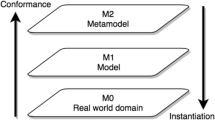Abstract
This position paper highlights current problems linked to the aspects of the multi-agency collaboration during disaster response. The coordination and cooperation depend on the information sharing and use which must face up to interoperability, access rights, and quality problems. The research project aims at providing an assessment of information impact on the disaster response in order to support the decision-making about what information shared or what quality of data used to improve the response efficiency. Our research approach propose to combine an information system able to integrate heterogeneous data and a simulation system to assess different strategies of information sharing, dissemination and use. A knowledge base is used as a bridge between information system and simulation system. This knowledge base allows for designing dynamically a simulation according to open data and for managing the own knowledge and information known by each agent.
Access this chapter
Tax calculation will be finalised at checkout
Purchases are for personal use only
Similar content being viewed by others
References
Copola, D.: Introduction to International Disaster Management, 2nd edn. Elsevier, Burlington (2011)
Gulati, R., Wohlgezogen, F., Zhelyazkov, P.: The two facets of collaboration: cooperation and coordination in strategic alliances. Acad. Manag. Ann. 6(1), 531–583 (2012)
Malone, T.W., Crowston, K.: What is coordination theory and how can it help design cooperative work systems?. In: Proceedings of the 1990 ACM conference on Computer-Supported Cooperative Work, pp. 357–370. ACM, September 1990
Bharosa, N., Lee, J., Janssen, M.: Challenges and obstacles in sharing and coordinating information during multi-agency disaster response: propositions from field exercises. Inf. Syst. Front. 12(1), 49–65 (2010)
Manoj, B.S., Baker, A.H.: Communication challenges in emergency response. Commun. ACM 50(3), 51–53 (2007)
Beneito-Montagut, R., Shaw, D., Brewster, C.: Web 2.0 and social media in disaster management: using web 2.0 applications and semantic technologies to strengthen the public resilience to disasters (disaster 2.0 emergency management agencies use and adoption of web 2.0.). Technical report, Aston University, UK (2013)
Poveda, G., Serrano, E., Garijo, M.: Designing emergency management services by ontology driven social simulation. IT CoNvergence PRActice 3(1), 17–32 (2015)
Management of a Crisis (MOAC) vocabulary. http://observedchange.com/moac/ns/
Emergel. http://vocab.ctic.es/emergel/
Saoud, N.B.B., Mena, T.B., Dugdale, J., Pavard, B., Ahmed, M.B.: Assessing large scale emergency rescue plans: an agent based approach. Int. J. Intell. Control Syst. 11(4), 260–271 (2006)
Balasubramanian, V., Massaguer, D., Mehrotra, S., Venkatasubramanian, N.: DrillSim: a simulation framework for emergency response drills. In: Mehrotra, S., Zeng, D.D., Chen, H., Thuraisingham, B., Wang, F.-Y. (eds.) ISI 2006. LNCS, vol. 3975, pp. 237–248. Springer, Heidelberg (2006). doi:10.1007/11760146_21
Praiwattana, P., El Rhalibi, A.: Survey: development and analysis of a games-based crisis scenario generation system. In: El Rhalibi, A., Tian, F., Pan, Z., Liu, B. (eds.) Edutainment 2016. LNCS, vol. 9654, pp. 85–100. Springer, Cham (2016). doi:10.1007/978-3-319-40259-8_8
Serrano, E., Poveda, G., Garijo, M.: Towards a holistic framework for the evaluation of emergency plans in indoor environments. Sensors 14(3), 4513–4535 (2014)
Durif, T.: Environnement informé sémantiquement enrichi pour la simulation multi-agents: application à la simulation en environnement virtuel 3D (Doctoral dissertation, Dijon) (2014)
Prudhomme, C., Homburg, T., Ponciano, J.J., Boochs, F., Roxin, A., Cruz, C.: Automatic integration of spatial data into the semantic web. In: WebIST 2017, April 2017
Author information
Authors and Affiliations
Corresponding author
Editor information
Editors and Affiliations
Rights and permissions
Copyright information
© 2017 Springer International Publishing AG
About this paper
Cite this paper
Prudhomme, C., Roxin, A., Cruz, C., Boochs, F. (2017). Towards the Design of Respond Action in Disaster Management Using Knowledge Modeling. In: Dokas, I., Bellamine-Ben Saoud, N., Dugdale, J., Díaz, P. (eds) Information Systems for Crisis Response and Management in Mediterranean Countries. ISCRAM-med 2017. Lecture Notes in Business Information Processing, vol 301. Springer, Cham. https://doi.org/10.1007/978-3-319-67633-3_14
Download citation
DOI: https://doi.org/10.1007/978-3-319-67633-3_14
Published:
Publisher Name: Springer, Cham
Print ISBN: 978-3-319-67632-6
Online ISBN: 978-3-319-67633-3
eBook Packages: Business and ManagementBusiness and Management (R0)




